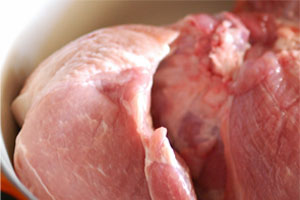US: Trade barriers, demand cause sluggish pork exports

Exports of US pork and beef in April edged higher than the previous month but still lagged behind year-ago levels, according to statistics released by USDA and compiled by the US Meat Export Federation (USMEF).
While the overall trend for exports remains sluggish driven by market access issues and oversupply of domestic product in key markets, several leading trading partners showed positive signs in April.
Beef exports to Japan were up sharply as the island nation regained its ranking as the No. 1 market for US beef for the first time since 2003. At the same time, Hong Kong maintained its rapid growth pace and Taiwan continued its rebound from beta agonist-related issues that slowed exports last year.
While the boost in exports to Japan is encouraging – up 49 percent in volume and 44 percent in value versus the first four months of 2012 – USMEF President and CEO Philip Seng cautioned that Japan has a safeguard in place that will boost tariffs if beef import volumes rise too quickly. This safeguard, which was utilized by Japan in 2003 under similar circumstances, remains an important consideration for US exporters and Japanese importers.
On the pork side, Mexico showed double-digit growth in April after a slow start to the year while Central/South America, the ASEAN region and the Caribbean all grew 30 percent or more for the month. US lamb sales were also up sharply to leading export markets.
Summary of April results
April beef export volume of 86,433 metric tons (mt) was down 9 percent from a year ago and export value was down 7 percent to $434.8 million. For January through April, beef exports were 2 percent higher in value ($1.75 billion) despite a 5 percent decline in volume (343,020 mt).
April pork exports totaled 174,073 mt valued at $475.1 million – down 5 percent and 7 percent, respectively, from a year ago. Through the first four months of the year, pork exports were 10 percent below last year’s pace in both volume (702,268 mt) and value ($1.96 billion).
Russia’s suspension of imports of US beef and pork, which officially closed the market Feb. 11, continues to hamper overall performance. USMEF estimates this trade impasse, which is related to Russia’s enforcement of a zero-tolerance policy for beta agonist use, has cost the U.S. industry about $97 million in beef export value and $58 million in pork export value so far in 2013.
“Along with our lack of access to sell beef in mainland China, this is the biggest barrier we face in terms of market access,” said Seng. “One often overlooked factor is the effect this suspension has on the price U.S. products command in markets other than Russia. For example, beef livers to Egypt have increased in volume, but the value is down. There is also downward pressure on the prices offered for rounds, hams and pork for further processing. The impact is much broader than many analysts realize at first glance.” Through April, beef exports equated to 9 percent of U.S. muscle cut production and 12 percent including variety meat – down from last year’s ratios of 9.6 percent and 12.7 percent. Export value equated to $217.54 per head of fed slaughter, up 3 percent from the same period last year.
Pork exports accounted for 21 percent of muscle cut production and 25.3 percent including variety meat. This is down from 24.6 percent and 28 percent, respectively, during the first four months of 2012. Export value for the first four months of 2013 equated to $52.72 per head slaughtered, down from last year’s pace of $58.84.
Pork exports to Mexico show signs of recovery; South America very strong
While January-April pork exports to Mexico were down 8 percent in both volume (190,464 mt) and value ($345.7 million) compared to last year, April proved to be a very strong month as volume (52,958 mt) increased 19 percent and value ($92.9 million) was up 20 percent. Other markets in the Western Hemisphere also performed extremely well in the first four months of 2013, including:
• Canada, where exports were up 4 percent in volume (74,817 mt) and 3 percent in value ($265 million) over last year’s record pace.
• Improved market access resulting from the recent free trade agreement helped push exports to Colombia significantly higher in both volume (7,823 mt, +71 percent) and value ($20.3 million, +56 percent), making it the leading destination in the Central/South America region.
• Exports to Chile continued to expand, increasing 28 percent in volume (7,349 mt) and 33 percent in value ($19.6 million).
• In the Dominican Republic, exports climbed 18 percent in volume (5,556 mt) and 22 percent in value ($12.9 million). Variety meat exports to the Dominican Republic actually declined, so this performance was driven by impressive growth in muscle cut demand.
“It is gratifying to see U.S. pork performing so well in our neighboring markets, and the April recovery in Mexico was especially critical,” Seng said. “The strong results in Mexico and Canada really underscore the importance of resolving our issues with country-of-origin labeling so that our exports don’t face retaliatory measures from these trading partners.”
Led by strong results in the Philippines, exports to the ASEAN region were up 41 percent in volume (20,781 mt) and 32 percent in value ($51 million). Exports to Taiwan were much improved in April, nearly tripling in volume and value from a year ago. This pushed Taiwan’s January-April totals ahead of last year’s pace by 2 percent in volume (7,136 mt) and 3 percent in value ($16 million).
Coming off a $2 billion performance last year, pork exports to Japan have struggled to maintain this pace in 2013. Through April, exports were down 12 percent in volume (143,264 mt) and 9 percent in value ($637 million). According to the Global Trade Atlas, Japan’s imports from all sources were 3 down percent in volume (311,548 mt) and 16 percent in value ($1.62 billion), with value declining for the market’s four leading suppliers: the U.S., Canada, Demark and Mexico.
January-April exports to the China/Hong Kong region were lower in both volume (135,300 mt, -13 percent) and value ($287 million, -8 percent), but this is mostly a reflection of low domestic prices, which have begun to stabilize in recent weeks. Exports to Korea were down for similar reasons, declining 35 percent in volume (43,613 mt) and 38 percent in value ($119.1 million).
For more info on beef and lamb exports, visit USMEF











